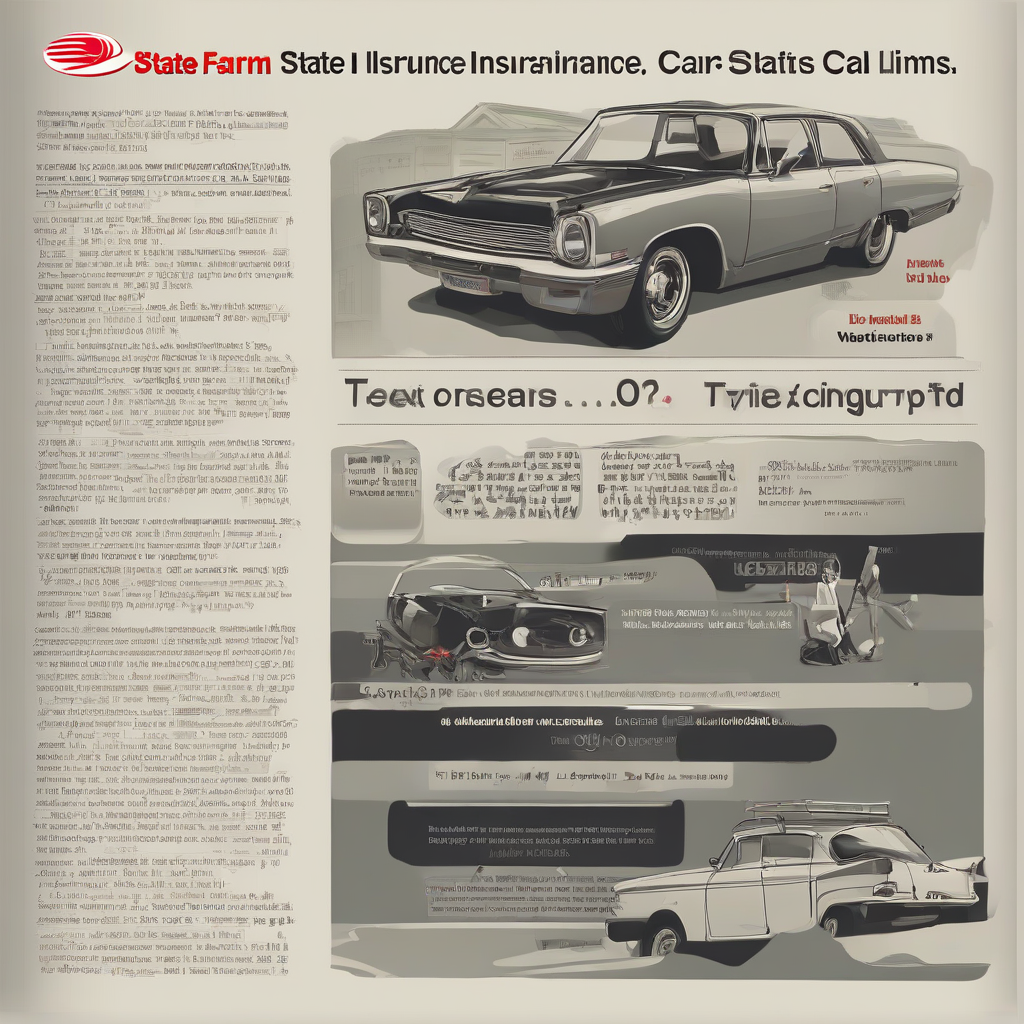Navigating the State Farm Car Insurance Claims Process: A Comprehensive Guide
Filing a car insurance claim can be a stressful experience, but understanding the process can significantly ease the burden. This comprehensive guide focuses specifically on State Farm car insurance claims, outlining each step, providing helpful tips, and addressing common concerns.
1. Immediate Actions After an Accident
- Ensure Safety: Prioritize the safety of yourself and others involved. Move vehicles to a safe location if possible, and call emergency services if needed.
- Gather Information: Collect crucial details from all parties involved, including names, contact information, driver’s license numbers, insurance information, and vehicle information (make, model, year, license plate number).
- Document the Accident: Take photos and videos of the damage to all vehicles involved, the accident scene (including road conditions and any visible signs of fault), and any visible injuries. Note the location, time, and date of the accident.
- Obtain Witness Information: If there are any witnesses, get their names and contact information.
- Report to the Police: Report the accident to the police, especially if there are injuries or significant property damage. Obtain a copy of the police report.
2. Reporting Your Claim to State Farm
- Contact State Farm Promptly: Report the accident to State Farm as soon as possible, typically within 24-48 hours. You can do this by phone, online through your State Farm account, or through the State Farm mobile app.
- Provide Necessary Information: Be prepared to provide the details you gathered at the accident scene, including the date, time, location, and circumstances of the accident. Be accurate and thorough in your account.
- Claim Number Assignment: State Farm will assign you a unique claim number. Keep this number handy for all future communication.
- Initial Claim Assessment: State Farm will begin an initial assessment of your claim, which may involve reviewing the information you provided and potentially contacting other involved parties.
3. The Claims Process: Steps to Expect
- Claim Assignment: Your claim will be assigned to a claims adjuster, who will be your primary point of contact throughout the process.
- Damage Assessment: The adjuster may schedule an inspection of your vehicle to assess the extent of the damage. You may be asked to take your vehicle to a State Farm-approved repair shop.
- Liability Determination: The adjuster will investigate the accident to determine liability, meaning who is at fault. This may involve reviewing police reports, witness statements, and photos.
- Negotiation and Settlement: Once liability is determined, the adjuster will work with you to negotiate a settlement. This involves determining the cost of repairs or replacement of your vehicle, as well as any other related expenses (e.g., rental car, medical bills).
- Payment of Settlement: Once the settlement is agreed upon, State Farm will process the payment. This could be directly to the repair shop, to you for repairs, or a combination depending on the circumstances.
4. Dealing with a Third-Party Claim
- Cooperation with Adjuster: If your claim involves another driver’s insurance company, cooperate fully with your adjuster and the other party’s adjuster. Provide all requested documentation promptly.
- Potential Disputes: Disagreements can arise regarding liability or the value of damages. Be prepared to negotiate and potentially involve an attorney if necessary.
- Understanding Subrogation: If State Farm pays for your damages and determines another party is at fault, they may pursue subrogation to recover their payments from the at-fault party’s insurance company.
5. Tips for a Smooth Claims Process
- Accurate and Timely Reporting: Report your accident to State Farm as soon as possible and provide accurate information. Delays can complicate the process.
- Maintain Good Documentation: Keep all documentation related to your claim, including photos, police reports, repair estimates, and communication with State Farm.
- Prompt Communication: Respond promptly to all requests from your adjuster. Don’t hesitate to ask questions if anything is unclear.
- Use State Farm-Approved Repair Shops: Using State Farm-approved repair shops can often streamline the repair process.
- Understand Your Policy: Review your State Farm insurance policy carefully to understand your coverage and the claims process.
- Consider Legal Counsel: If you’re facing significant difficulties or disputes, consult with an attorney specializing in insurance claims.
6. Common Issues and How to Address Them
- Claim Denials: If your claim is denied, understand the reasons for the denial and explore options for appeal. This may involve providing additional evidence or seeking legal advice.
- Delayed Payments: If your payment is delayed, contact your adjuster to inquire about the status of your claim. Delays can be caused by various factors, such as incomplete documentation or ongoing investigations.
- Disputes over Liability: Disputes over liability are common. Be prepared to provide evidence supporting your position, such as witness statements, photos, and police reports.
- Unfair Settlement Offers: If you believe the settlement offer is unfair, negotiate with the adjuster. If you cannot reach a satisfactory agreement, you may need to seek legal advice.
- Dealing with Uncooperative Parties: If you’re dealing with an uncooperative party, document all attempts to communicate and consider seeking legal advice.
7. Utilizing State Farm Resources
- State Farm Website: The State Farm website provides detailed information on filing a claim, including FAQs and online tools.
- State Farm Mobile App: The State Farm mobile app allows you to report a claim, track its progress, and communicate with your adjuster.
- State Farm Customer Service: Contact State Farm customer service if you have any questions or concerns about your claim.
8. After the Claim is Settled
- Review the Settlement: Carefully review the final settlement to ensure it accurately reflects the agreed-upon terms.
- Maintain Records: Keep all records related to the claim for your records.
- Future Premium Implications: Understand how your claim might affect your future insurance premiums. High frequency of claims can lead to higher premiums.
